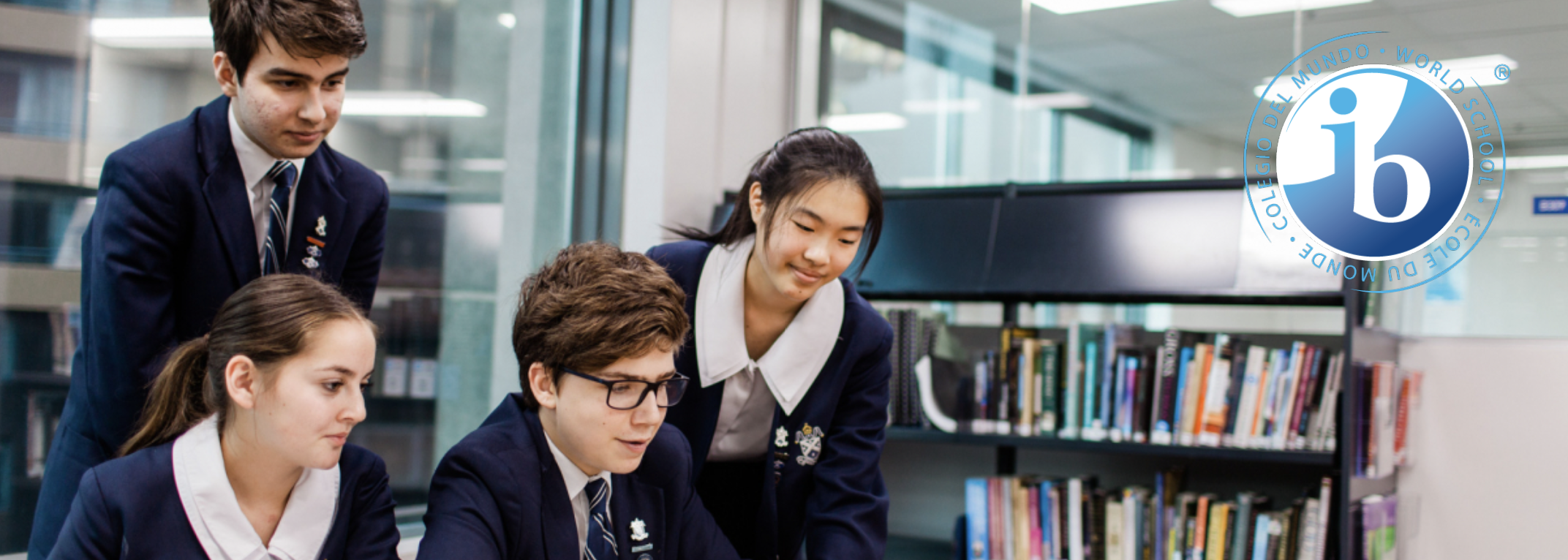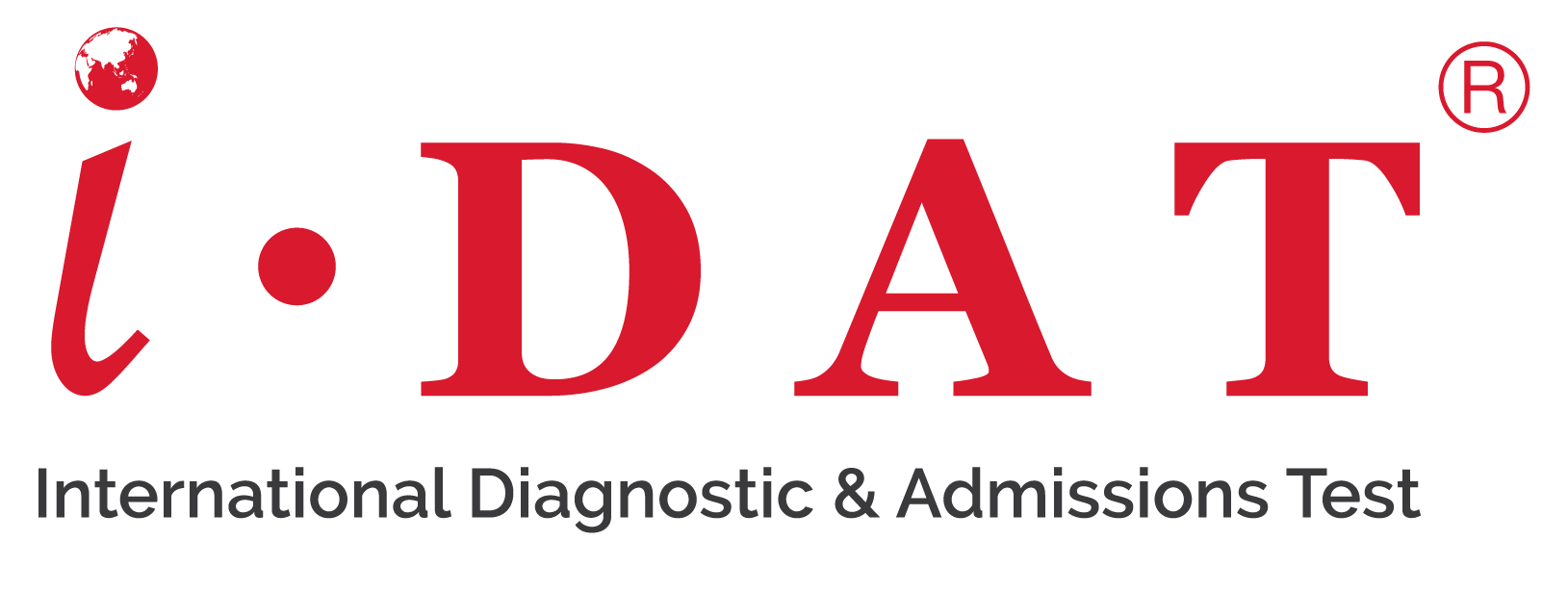ADMISSION TEST FOR IB DIPLOMA
The test just for IB Diploma entry

NEW IDAT FOR IB ADMISSIONS TEST
As a global sponsor for the IB conferences in 2019, IDAT has been listening to their IB school partners and as a response has created a specific IB Diploma entry assessment.
While much of the IB program requirements mirror the global needs of a Year 10 student, there are specific attributes of an IB student that create success in this globally recognised program. From this we have created a test that is just for IB Diploma entry.
The IDAT for IB goes further than an assessment of academic skills, knowledge and character. The IDAT for IB also evaluates critical thinking skills in terms of ability to analyse, reflect and express critical thought.
HOW IS THE IDAT FOR IB ASSESSMENT DIFFERENT TO THE STAGE 5 & STAGE 6 ASSESSMENT?
The tests are the same for mathematics, character and English skills in speaking, listening, grammar and vocabulary. However, just as the IB program requires students to be able to critically evaluate sources, their own learning and to think critically, the IDAT for IB has adapted the writing and reading components to more carefully evaluate critical thinking skills.
The reading assessment requires students to read excerpts of short stories from classic or famous authors. In addition to comprehension questions, the student must be able to identify mood, theme and literary devices.
The written tasks require students to explain and evaluate thematically grouped quotes from famous people throughout history. The students must be able to explain the quote and critically evaluate what they think of the sources, the value of the quotes and the meanings. The students must also define more difficult vocabulary associated with themes of knowledge, learning and social justice ‘in their own words’ and be able to construct paragraphs using these words to express opinions and points of view.
WHAT DO RESULTS IN IDAT FOR IB LOOK LIKE?
The IDAT for IB results will give an overall result in terms of classroom readiness for critical thinking skills. This is calculated through evaluation of writing and reading, looking at critical analysis, critical reflection and critical expressions. Essentially, how well a student can analyse a text and source, how they approach the sources to ascertain value and meaning, and how well can they express their thoughts about the sources and texts. Please see the IDAT results page for more detailed information on how these skills are given a qualitative value.
HOW CAN STUDENTS PREPARE FOR THE IDAT FOR IB?
Please go to our preparation page for reading and writing. In addition to preparing what is advised for vocabulary and question type, students will see additional vocabulary and advice on the page specific to IDAT for IB.

ENGLISH CURRICULUM
GRAMMAR AND VOCABULARY
20-25 MULTIPLE CHOICE
Students have 20-25 multiple choice for each of grammar and vocabulary (depending on their stage and level). The student does one question at a time and has up to 30 seconds for each question The student cannot return to the question after submitting the answer, so please check work before hitting the button for the next question.
READING
2 READINGS, UP TO 10 QUESTIONS PER READING
Students must read a passage and answer comprehension and contextualised vocabulary questions as required for the reading. There are up to 10 questions per reading and time limits are indicated at the top of the page.
The time limit is based upon the length of the reading and how many questions there are to answer.
WRITING
2 QUESTIONS
With visual stimulus, students are required to type an extended prose about what they see in the picture. Students should answer all the prompting questions and explain themselves in full sentences. Students need to self-edit their own work. The computer system will now allow for autocorrect of spellcheck. Students are given ample time to read over their prose and self-correct. Students are marked on the complexity of writing, accuracy and ideas.
INTERVIEW (LISTENING AND SPEAKING)
10 QUESTIONS
The interview is conducted by an avatar and students spoken answers are recorded.
The questions are asked by an avatar. Students can push a button to have the question repeated, asked in another way, or asked more slowly. They can only use each of these buttons once, but it will deduct 5 scores for each time. The student can take notes on blank paper before speaking but the paper must stay in the room. Students are encouraged not to read off the paper when they speak, as it will not help the student to make eye contact and a good impression. The student presses a button when he or she is prepared to answer, and this will video record their answers. Students are expected to give length answers (limited to 2 minutes per answer) which provide insight into who they are and show the school their speaking and comprehension skills for listening.
When a student has finished recording their answer, they push the button for the next question. No answer or speaking can be erased and tried again. There is one try only.
Prospective or current schools allocated by the student may view this interview with a one-time login password when results are available
MATHEMATICS CURRICULUM
MATHEMATICS
24-48 MULTIPLE-CHOICE MATH QUESTIONS
- 24-48 multiple-choice questions, depending on different test stages.
- 2-3 questions per type of math topic. Please refer to the outlined stage tests for details.
- For questions requiring a calculator, the calculator will appear on the screen for students to use.
- Calculator is provided in the test system for relevant questions.
- Blank paper and a pencil will be provided by test centres. The pencil and paper must not be taken out of the test room.
- Each question has up to three (3) minutes for student to answer.
- The student cannot return to the question after submitting the answer, so please check work before hitting the button for the next question.
GLOBAL KNOWLEDGE CURRICULUM
GLOBAL KNOWLEDGE
18 MULTIPLE-CHOICE QUESTIONS
- Total of four (4) parts included in the Global Knowledge section: Logic, Science and Technology.
- All questions are multiple choices.
- Logic questions consist of IQ testing questions such as transformation, patterns, problem-solving and deduction. The purpose of this is to show a student's ability to think critically about a variety of questions. Critical thinking is an important part of global studies.
- The Science and Technology sections are based upon topics taken from a survey of global school curricula and are appropriate to age and level.
CHARACTER
36 MULTIPLE CHOICE
- There are total of 36 multiple-choice questions which demonstrate a student’s skill level and appetite for risk-taking, collaboration, self-awareness, communication and creative thinking.
- There are no ‘right’ or ‘wrong’ answers and the student’s character is assessed in terms of skills and tendencies. There is no judgement element in this assessment; it is simply a way for schools to get to know the executive skills of students.
SELF-AWARENESS
Self-awareness helps kids learn that how they see themselves may be different from how others see them. Students who are able to recognise their strengths as well as their weaknesses. Self-awareness is the thinking skill that focuses on a child’s ability to accurately judge their own performance and behaviour and respond appropriately to different social situations. Self-awareness helps an individual to tune into their feelings, as well as the feelings of others.
RISK-TAKING, ADAPTATION AND RESILIENCY
This will look at how students view opportunities for challenge, testing limits, exploring boundaries and learning about injury or risk. It will look at how the student engages in things where there is the possibility that something bad or unpleasant will happen and how they face challenges and uncertainties within the environment. The test will ascertain how students learn, how they manage their own learning and what they do when they encounter risk.
CREATIVITY AND PROBLEM SOLVING
The ability to produce original or unusual ideas, or to make something imaginative. This will look at the mental characteristics that allow a person to think outside the box which results in innovative or different approaches to a particular task or problem.
COMMUNICATION AND EMPATHY
This is looking at the skills needed to use language (spoken, written, signed or otherwise communicated) to interact with others and how through the ability of the student to convey their ideas and function in different environments they have the capacity to place oneself in another’s position. This is about a person’s standards of behaviour or beliefs concerning what is and is not acceptable for them to do
TEST FORMAT FOR IB
Details of each section of the test
IDAT for IB Stage 5
Students applying Aus/US/Can Year 9, 10 or beginning Year 11. UK Year 10, 11, beginning Year 12
Total test time: 175 minutes
| English: Vocabulary,Grammar, Reading and Writing | English: Listening & Speaking | Mathematics | Global Knowledge | Character | Critical Thinking |
| 45 mins + 35 mins | 25 mins | 35 mins | 15 mins | 20 mins | |
|
|
|
*(Global knowledge preparation) |
| This is incorporated into writing & reading sections
|
IDAT for IB Stage 6
Students applying Aus/US/Can Year 11, 12. UK Year 12, 13
Total test time: 180 minutes
| English: Vocabulary,Grammar, Reading and Writing | English: Listening & Speaking | Mathematics | Global Knowledge | Character | Critical Thinking |
| 50 mins + 35 mins | 25 mins | 35 mins | 15 mins | 20 mins | |
|
|
|
*(Global knowledge preparation) |
| This is incorporated into writing & reading sections
|
CRITICAL THINKING QUALITATIVE DESCRIPTORS
Critical Thinking Sections are based on the following qualitative descriptors
DESCRIPTORS CRITICAL ANALYSES
Student lacks the language to be able to analyse the texts in a basic way.
Misses, mis-identifies or mis-states some key/obvious points.
Merely lists or describes points in the material, without fully understanding what has been read. Incorrectly describes important facts or relationships.
Appropriately identifies and describes main points in a text or an issue. Can apply previous knowledge to materials to draw obvious conclusions.
Identifies critical points that are typically overlooked and uses some original ideas regarding the materials.
Can connect complex ideas using imagery, analogies and symbolism from a range of sources. Can identify and interpret main points and analyse information for rationale and evidence. Displays insight regarding the material.
DESCRIPTORS CRITICAL REFLECTION
Fails to produce an outcome that is accurate, usable or acceptable. Does not meet the objective or purpose of the task.
Merely lists or describes facts without exposing relationships among facts.
Student able to come up some original ideas and explanations but lacks cohesion. Some points not relevant to purpose.
Can accurately describe relevance of points. Student able to think logically and thoroughly about information and apply solutions but may lack originality or independent thought.
Can critically analyse sources to determine possible bias. Can use logical and abstract information to synthesise information to create explanations and identify thoughts and processes.
Creatively and appropriately applies principles or procedures. Can insightfully and thoroughly explain ideas and creativity.
DESCRIPTORS CRITICAL EXPRESSION
Student lacks the language to be able to express thoughts in a critical way.
Fails to explain self accurately. Student can write some thoughts and ideas but lacks base vocabulary or grammar, which interferes with meaning of expression.
Adequately applies structure of writing and addresses the issue but lacks originality and cohesion of thought and conclusion.
Can accurately describe relevance of points. Can correctly and logically defend own point of view.
Student can give reasons to support their thinking, addressing opposing viewpoints and possible weaknesses to their position. Can identify, plan and transfer knowledge to new contexts.
Develops and creates an outcome that is accurate and proper yet novel or outstanding. Ability to exceed basic purpose of objective.

